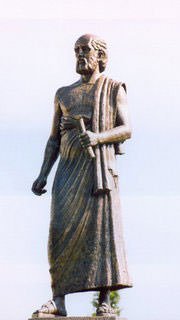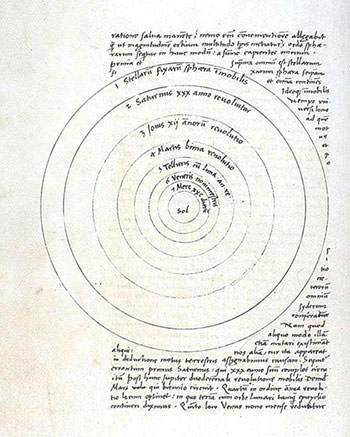Nicolaus Copernicus is famous for being the primary man behind changing the age old belief that the earth was at the center of the universe. His revolutionary work De revolutionibus orbium coelestium started a revolution which made people accept the heliocentric model of universe. Here are 10 interesting facts about the great astronomer.
#1 HIS NAME CAN BE TRACED TO THE METAL COPPER
Copernicus was born as Nicolaus Koppernigk in the city of Torun on 19 February 1473. His mother Barbara Watzenrode belonged to a rich family in Torun. Copernicus was named after his father Nicolaus Koppernigk whose family can be traced to the Koperniki village in Silesia. Hence the surname Koppernigk. The village in turn took its name from the German term (kopper) for the metal (copper) that was mined there.

#2 HE HELD THE POSITION OF CANON IN CHURCH
In 1483, when Copernicus was only 10 years old, his father passed away. His maternal uncle Lucas Watzenrode took care of him and made sure he received the best of education. In 1494, his uncle Lucas, who was the bishop of Warmia, helped him secure the position of a canon, an administrative appointment in the Church. Copernicus held the position throughout his life and it helped him fund his studies and research. He never married, nor had children.

#3 He WAS NOT THE FIRST TO PROPOSE THE HELIOCENTRIC MODEL
Copernicus is most famous for the heliocentric astronomic model developed by him which placed the Sun at the center, motionless with earth and other planets revolving round it. Prior to the heliocentric model, Ptolemy’s geocentric model was the accepted model for centuries. It put earth at the center of the universe with all planetary bodies revolving around it. But Copernicus was not the first to suggest the heliocentric model, similar models had been put forward by a few astronomers, most notably Aristarchus of Samos (310 BCE – 230 BCE). Yet Copernicus’s solar system was more detailed and provided a more accurate formula for calculating planetary positions.

#4 HE WAS AFRAID THAT PEOPLE WILL RIDICULE HIS WORK
Copernicus had more or less completed writing De revolutionibus orbium coelestium, the book in which he argued in favor of the heliocentric model, in 1532. But his work was not published till 1543.This was because Copernicus kept delaying its publication as he didn’t want to risk the scorn “to which he would expose himself on account of the novelty and incomprehensibility of his theses.”
#5 DE REVOLUTIONIBUS ORBIUM COELESTIUM WAS A ‘WORST SELLER’
Although De revolutionibus orbium coelestium is now considered one of the most important works in astronomy, it failed to sell even 400 copies when it was published and was considered mathematical fiction. Arthur Koestler described De revolutionibus as “The Book That Nobody Read” saying the book “was and is an all-time worst seller”. However, even at that time, some astronomers did consider it as a worthy successor to Ptolemy’s Almagest.

#6 HIS WORK LAUNCHED THE SCIENTIFIC REVOLUTION
During the lifetime of Copernicus and even many years after his death, Ptolemy’s model was the generally accepted model. However Nicolaus Copernicus’s De revolutionibus orbium coelestium did start the Copernican Revolution which lasted for a century and a half till the works of other scientists finally established the heliocentric model. The Copernican Model is also regarded as the launching point of modern astronomy and the Scientific Revolution.

#7 HE GOT A GLIMPSE OF HIS PUBLISHED BOOK JUST BEFORE HIS DEATH
In late 1542, Copernicus was seized with apoplexy and paralysis. He died at the age of 70 on 24 May 1543. Legend has it that just before Copernicus died he was given the printed pages of his book. It is said he woke from a stroke induced coma, took a look at his book and then died peacefully knowing his life’s work was finally out.

#8 COPERNICUS WAS A NOTABLE ECONOMIST
Apart from being an astronomer, Copernicus had a doctorate in canon law and was also a physician, polyglot, classics scholar, translator, governor, diplomat and most notably an economist. However, it is interesting to note that he didn’t have a degree for any of these. He also knew five languages: Latin, German, Polish, Greek and Italian.
#9 He FORMULATED The QUANTITY THEORY OF MONEY
In economics, Copernicus set forth the Quantity Theory of Money which stated that if the supply of money is increased, the price of goods will also increase proportionately. The theory was improvised by many economists and still remains an important concept in economics. It was very popular in the 1980s among major economies including the U.S. and U.K.

#10 AN ELEMENT HAS BEEN NAMED AFTER COPERNICUS
The chemical element Copernicium (Cn) with atomic number 112 is named after Nicolaus Copernicus. The name was officially accepted and announced on 19 February 2010, the 537th anniversary of Copernicus’ birth.


this helped in my research
Happy to help.